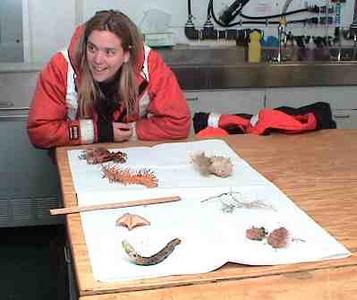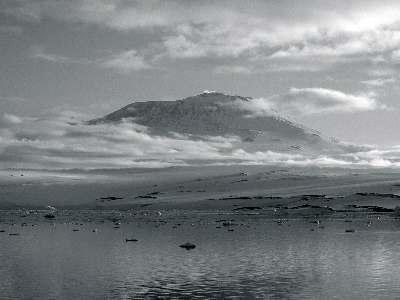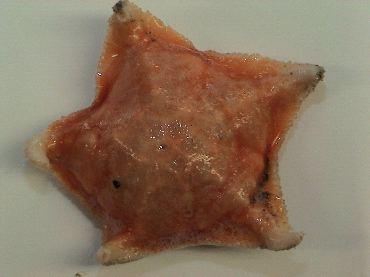30 January, 2004
Dredge #3 was in the water at 2:00 AM, dragging across the second
seamount in the cluster of seamounts that we started dredging
yesterday. Dredge #2 from the 29th was a bit disappointing because of
the small number of rocks that were collected and the rocks on dredge
#2 were covered in thick muddy sediment.
When dredge #3 came on board, all of the contents were easily
identifiable. There was very little mud on any of the samples.
Cleanup was minimal. The contents of the dredge were easily separated
into rocks and living organisms. Since the living things were so easy
to collect, we put the rocks in one container and the "live stuff" in
the other. It was a nice diversion for all of us to take a look at
what had made the trip up with the rocks. Sam Mukasa speculated that
the lack of mud and sediments might indicate that this volcanic
feature is younger that from dredge #2. A younger seamount would
conceivable had less time for sediment to accumulate than an older
one.
The living organisms that were in the dredge were easy to separate
and collect. We found a variety of starfish, brittle stars, sea fans,
coral, and worm s and their casings along with the rocks in the
dredge. After taking the organisms back to the hydro lab, we laid
them out on the lab table to take photos. All of these organisms
would have to be returned back to the ocean. Taking samples of any
type from Antarctica into New Zealand requires special permits. These
permits have to be acquired in advance. Since there were no
biologists on this cruise, we didn't get a permit to transport
biological specimens. Even without a permit, we took this opportunity
to observe and catalog what we had "accidentally" collected during
the dredge.
These organisms caught in the dredge had been living at a depth of
about 600 feet. They live in the very harsh Antarctic environment,
but they look very similar to their relatives that live in the
temperate and tropical oceans. We collected two starfish. One
appeared to be a juvenile and the other an adult of the same species.
They did not have the distinctive suckers on the ventral side of
their arms that are commonly seen on starfish in warmer climates. The
body was nearly circular, like a ball of play dough that had been
slightly smooshed. They are very interesting animals. Their skin was
smooth with a leathery texture on both the dorsal and ventral sides.
The sea fans and brittle stars looked more like their typical warm
ocean counterparts. The fans were a deep maroon, with variations from
red to black. Each of the plumes was very delicate and extending from
a thick base arranged alternately. The arrangement looked like how
the stalks are arranged around celery plants, one inside the next.
These organisms have very interesting ways of keeping themselves
attached to the bottom. The tubeworms have a modified suction cup
that has a may exert a vacuum hold on the mud or rocks. The sea fans
have extensions at the base that look almost like roots even though
they are definitely animals.
Even though the scientists are primarily interested in the rocks and
geophysics of the area, we informally discussed the different animals
that had been collected in the dredge. Marcy Davis was holding a
solitary coral and said the last time she saw one of these it was a
fossil. It could have been a distant relative of the one we caught in
the dredge.
Following the dredge, we continued with the multibeam survey, moving
south back into McMurdo Sound. The plan was to survey the area and
get a feel for how much open water and how much fast ice was in the
sound. The goal was to do a seismic survey of the area to tie
together data that had been collected by US, Kiwi, and Italian
geophysicists over the past twenty years or so.
Terry Wilson, Larry Lawver, Stuart Henrys and Sam Mukasa met on the
bridge to discuss the plan for the next few days. After a bit of
discussion about ice conditions, methods of doing seismic, and future
areas to attempt dredging, a preliminary set of shot lines were
identified. The scientist then discussed their ideas with the marine
support staff to get their input.
A decision was made to use a different type of seismic streamer that
collects data using one channel of data rather than many channels.
This streamer is about 150 meters long, which is about a tenth as
long as the multichannel streamer and can be operated using fewer
guns. It can also be pulled in very quickly if the ice conditions get
severe. The single channel streamer is also less likely to get caught
and damaged in the ice.
Preparations were made for both the single and multichannel
streamers. We continued to survey along the ice edge down along B15A,
then C16 then along the sea ice along the cost of McMurdo Island. The
views were spectacular as we cruised past Mount Erebus and in front
of Discovery Island. As the ship rounded the ice edge, we were able
to see the ice tongues of Terror Glacier and other glaciers on the
eastern coast of McMurdo Sound.
--

Marcy Davis takes a look at the different living organisms that were brought up with dredge #3.

Picture of Mount Erebus from the ice edge of McMurdo Sound.

Large starfish caught in dredge #3. --

Contact the TEA in the field at
.
If you cannot connect through your browser, copy the
TEA's e-mail address in the "To:" line of
your favorite e-mail package.
|
